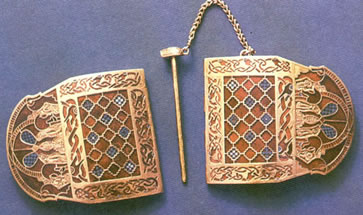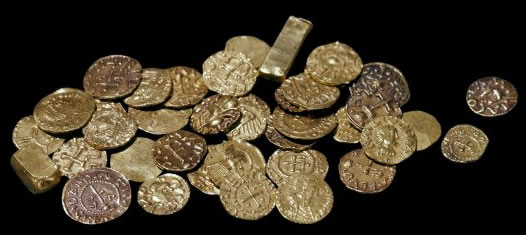

Metal detecting holidays in England with the World's most successful metal detecting club.20 years plus.
Twinned with Midwest Historical Research Society USA.
|
The armour at Sutton Hoo appears to be Swedish, or at least it is made in the Swedish style. Certainly the custom of ship burials is a Nordic one - there are many similar Viking remains in Denmark and Sweden. There is also a large silver dish made in Byzantium about 500 AD and a set of 10 silver bowls from the Mediterranean. Conjecture focuses on Redwald, a Saxon "bretwalda", or king, of East Anglia. According to the Venerable Bede in his "Ecclesiastical History", Redwald ruled East Anglia in 616, although his power may have stretched as far north as the Humber. Redwald was the first East Anglian king to pay any heed to Christianity. He may have converted to the new religion - certainly his successors were Christian.
Archaeologists have reconstructed how the burial at Sutton Hoo must have taken place. A long trench was dug atop a 100 ft. high cliff above the river Deben. The ship was dragged up from the river and set in the trench. A hut was built in the centre of the ship, and there was placed a large coffin and the grave goods. The trench was then filled in and a large mound erected over the top.
The importance of Sutton Hoo cannot be overstated. From the grave goods we can learn a lot about the pattern of life in this darkest part of the Dark Ages in Britain. Even the style of the craftsmanship lets us draw conclusions about how strong were Saxon connections with rest of Europe.In this case it seems clear that there was a strong Norse influence in East Anglia, but also ties to Gaul and the Mediterranean. Clearly, trade with those areas was maintained throughout these troubled times. The goods discovered at Sutton Hoo are on display at the British Museum in London.
Purse
At Sutton Hoo, 37 Merovingian coins were found, the latest of which dates to the 620s.
Merovingian gold tremissis
of the moneyer Ioannes (John) of Cadolidi or Capolidi, probably early
7th century. The front shows a very crude diademed bust, probably facing
left. The back shows an unusual cross, probably derived from a Byzantine
cross-on-steps design. Although very little of the inscription can be
read, it can be identified from its similarity to another coin, now
in Paris. The location of Cadolidi/ Capolidi is uncertain.
|
 |

 In
1939 archaeologists unearthed an amazing Anglo-Saxon ship burial in
Woodbridge Suffolk; amazing both for the state of preservation of the
objects within the tomb, but also astonishing for the sheer rich quality
of the artifacts. The burial goods from Sutton Hoo are remarkable -
gold weapons and armour, inlaid ornaments, silver and tableware. Also
found with the body was a purse containing 37 gold Merovingian (Gaulish)
gold coins dating from the 620's AD.
In
1939 archaeologists unearthed an amazing Anglo-Saxon ship burial in
Woodbridge Suffolk; amazing both for the state of preservation of the
objects within the tomb, but also astonishing for the sheer rich quality
of the artifacts. The burial goods from Sutton Hoo are remarkable -
gold weapons and armour, inlaid ornaments, silver and tableware. Also
found with the body was a purse containing 37 gold Merovingian (Gaulish)
gold coins dating from the 620's AD. 


 When
the ship was uncovered the timbers had rotted away. However, the rivets
still remained, and the rotting timbers had stained the sand, so the
pattern of boat construction could be determined, and a good picture
of the boat emerged. It was about 90 feet long and 14 feet wide, with
a high bow and stern. It is easily the largest Anglo-Saxon ship ever
discovered.
When
the ship was uncovered the timbers had rotted away. However, the rivets
still remained, and the rotting timbers had stained the sand, so the
pattern of boat construction could be determined, and a good picture
of the boat emerged. It was about 90 feet long and 14 feet wide, with
a high bow and stern. It is easily the largest Anglo-Saxon ship ever
discovered.



